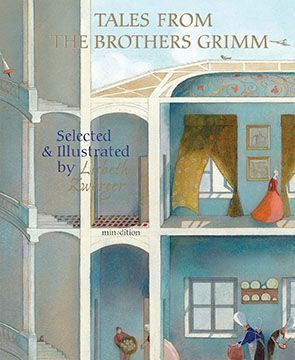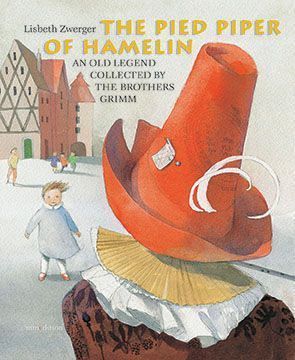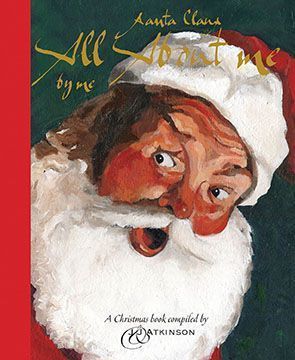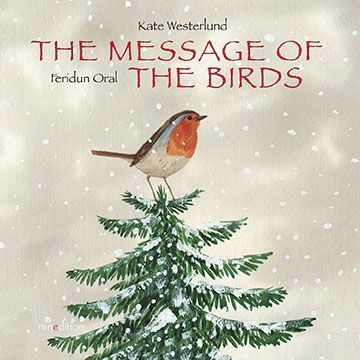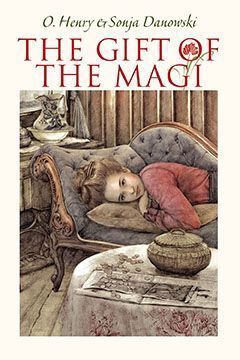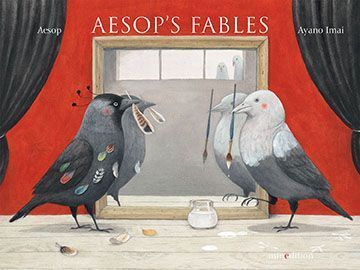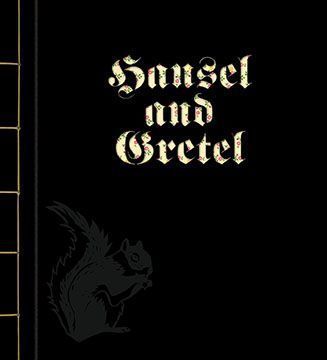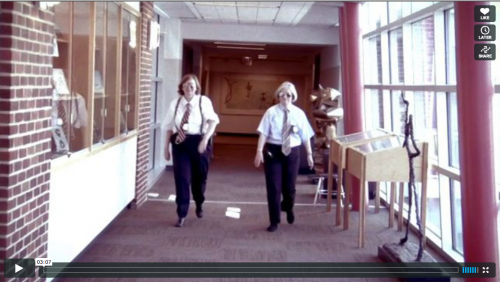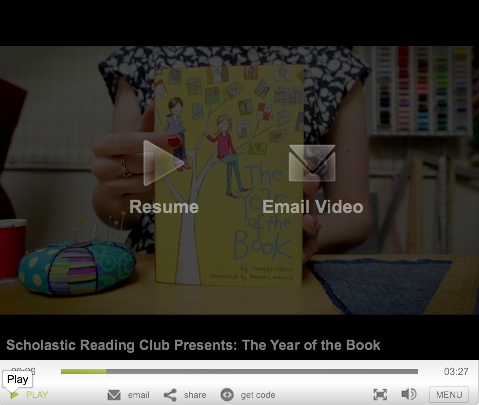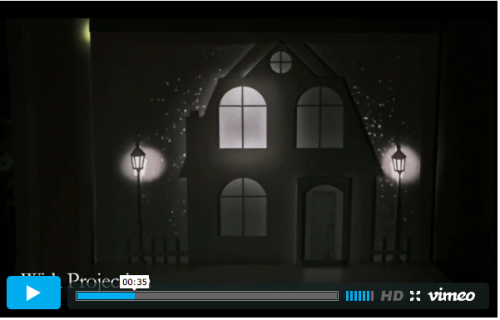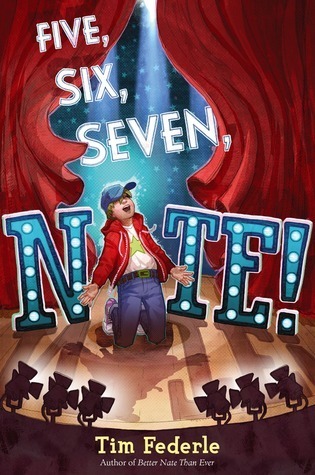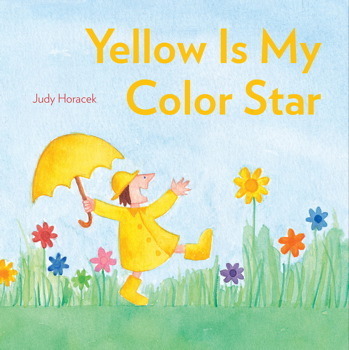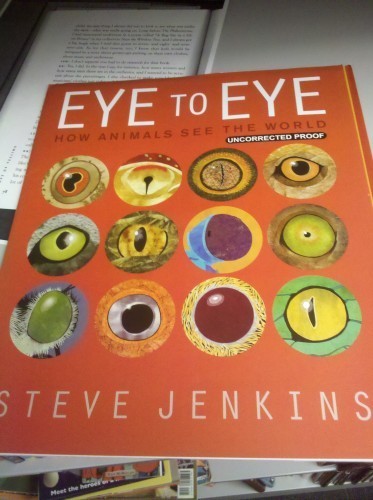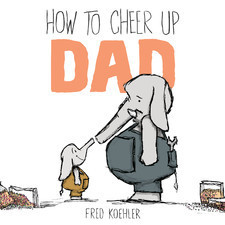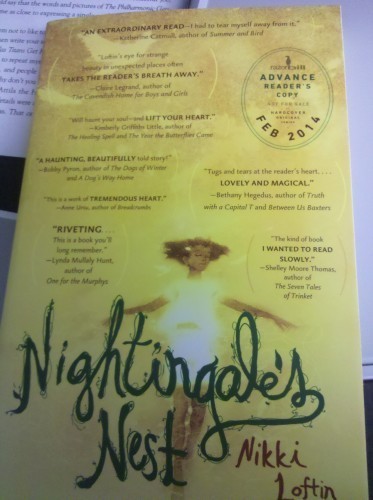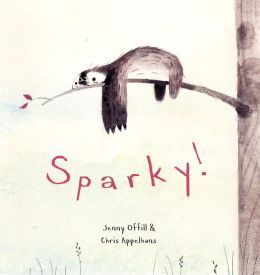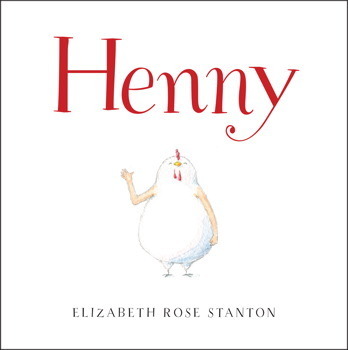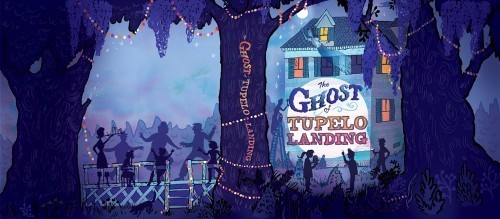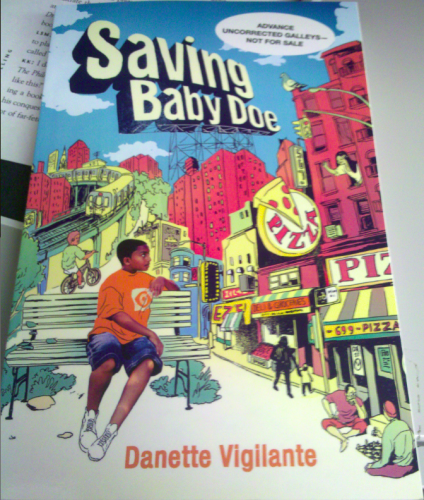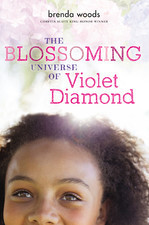Betsy Bird's Blog, page 305
September 6, 2013
Don’t Cry, Darling, It’s Blood All Right
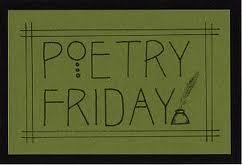 I was recently delighted to find myself a guest of a friend at Martha’s Vineyard this past Labor Day weekend. Not having been before I didn’t really know what to expect. On the whole my family and I found the weekend sublime and tasty, as lobsters are common there and very cheap to eat.
I was recently delighted to find myself a guest of a friend at Martha’s Vineyard this past Labor Day weekend. Not having been before I didn’t really know what to expect. On the whole my family and I found the weekend sublime and tasty, as lobsters are common there and very cheap to eat.
The home in which we stayed was a family cottage and there were several generations worth of books inside. While perusing the children’s section (where I found gems like 1980s Apple paperbacks of Mary Lee Hahn’s serious children’s novels without a ghost in sight) I ran across a little book of poetry called Parents Keep Out by Ogden Nash. From what I can tell it was published by Little, Brown and Company sometime around 1933 initially, though this particular edition was in its eleventh printing and was from 1951. Reading the Introduction feels like nothing so much as a dip into the world of Lemony Snicket. A sample:
“Since parents can’t keep out of anything, I resignedly address these words to them. Many parents will find that they have read some of the verses in previous book of mine. I shall not apologize. Anybody who has read previous books of mine is a trespasser in this one, which has been compiled for a younger generation. I do not regard it as a children’s book, however; I simply hope it is a book that anyone born less than fourteen or fifteen years ago many enjoy.”
It goes on to compare the speech that goes on between adults and children as akin to that of diplomats from foreign countries and says that if children like this book then “it is for the very reason that the Kremlin is gratified by any sign of the collapse of capitalism; watchful young eyes may here perceive indications of the breakup of the old people’s world.” What then follows are about 120 poems of varying lengths sporting titles like “Barmaids Are Diviner than Mermaids”, “The Passionate Pagan and the Dispassionate Public”, “Epstein, Spare that Yule Log!”, etc.
It was in my reading that I came across today’s thoroughly grand poem. One that shows that the more things change, the more things stay the same. Read it and try as you might not to think of Adam Gidwitz and his Grimm series. I dare you.
DON’T CRY, DARLING, IT’S BLOOD ALL RIGHT
Whenever poets want to give you the idea that something is particularly meek and mild,
They compare it to a child,
Thereby proving that though poets with poetry may be rife
They don’t know the facts of life.
If of compassion you desire either a tittle or a jot,
Don’t try to get it from a tot.
Hard-boiled, sophisticated adults like me and you
May enjoy ourselves thoroughly with Little Women and Winnie-the-Pooh,
But innocent infants these titles from their reading course eliminate
As soon as they discover that it was honey and nuts and mashed potatoes instead of human flesh that Winnie-the-Pooh and Little Women ate.
Innocent infants have no use for fables about rabbits or donkeys or tortoises or porpoises,
What they want is something with plenty of well-mutilated corpoises.
Not on legends of how the rose came to be a rose instead of a petunia is their fancy fed,
But on the inside story of how somebody’s bones got ground up to make somebody else’s
bread.
They go to sleep listening to the story of the little beggarmaid who got to be queen by
being kind to the bees and the birds,
But they’re all eyes and ears the minute they suspect a wolf or a giant is going to tear
some poor woodcutter into quarters and thirds.
It really doesn’t take much to fill their cup;
All they want is for somebody to be eaten up.
Therefore I say unto you, all you poets who are so crazy about meek and mild little
children and their angelic air,
If you are sincere and really want to please them, why just go out and get yourselves
devoured by a bear.
- Ogden Nash, Parents Keep Out
Today’s Poetry Friday is being hosted by Author Amok. Head on over there for the full round-up.
September 5, 2013
Librarian Preview: minedition (Winter 2013 / Spring 2014)
 I do declare that it has been something like a year since I did a good old-fashioned Librarian Preview. Where has the time gone? For a bit I was so overwhelmed by the sheer amount of work such a preview requires that I cut them out of my diet, cold turkey.
I do declare that it has been something like a year since I did a good old-fashioned Librarian Preview. Where has the time gone? For a bit I was so overwhelmed by the sheer amount of work such a preview requires that I cut them out of my diet, cold turkey.
Well that ends today. From here on in we’re doing our Librarian Previews like it’s nobody’s business. Today’s is a perfect example of why. I’m sure you have all sorts of outlets for learning about minedition and their amazing books, but today I’m the one shining the spotlight. And what I see pleases me immeasurably.
But first, the basics. Mainly: What the heck is minedition? For some of you the name is vaguely familiar. It rings a distant bell. Well an explanation is easily found on their website. To quote: “Five years ago michael neugebauer edition was newly founded after the publisher Michael Neugebauer ended his affiliation with the Swiss Nord Süd Publishing.” The very word “minedition” is a combination of the letters “mi” from Michael, “ne” from Neugebauer and “edition”. He’s a fascinating feller too. His father was a calligrapher (one of the best in the world, it seems) who gave his son a unique appreciation for fonts, layouts, and design. Michael himself went on to do many things before minedition, including serving as Jane Goodall’s favorite photographer. You know that picture at the end of Me…Jane that just rips your heart out of your chest? Michael took that.
But it’s this statement on the website that I like the best: “When children are exposed to exceptional books, if they have the chance to discover amazing books, they can develop much more than just a deeper appreciation of word and art. Such books can foster understanding and a greater appreciation of the multi-cultural world in which we live.”
Amen to that. So enough with the chitty chat. Let’s see what minedition has put on the table.
First up: The board books!
This would be We Love Each Other by Yusuke Yonezu (ISBN: 9789888240562). Now I appreciate a publishing company, particularly an artsy one like minedition, that understands how very difficult it is to make a good board book. A good board book is a like a homemade loaf of bread. On the surface it seems like it would be easy to make but there are subtleties involved. Thus far the author Yusuke Yonezu is unknown to our fair shores but I expect all of that to change soon. First of all, this book is pretty much brilliant. It shows animals apart who, when put together, make different shapes. Circles, squares, triangles, you name it. The art is bold, colorful, simple, funny, sweet, touching, all that stuff. And it’s just a friggin’ board book! The additional good news is that it’s not the only one this year:
Yum Yum, also by Yusuke Yonezu (ISBN: 9789881595355 ) isn’t out until the spring. Various healthy foods are presented and with a flip of a page you get to see various animals eating them. A mouse likes cheese, a pig likes an apple, a rabbit likes carrots, etc. Get to the end, though, and a human kid is there. And instead of a single food, he likes to eat everything that was already mentioned. It’s sort of a subtle good food message, but with these adorable illustrations. I mean seriously. Look at that cat up there. Can you resist that? Really?
From board books we travel to the world of fairy tales . . .
This would be Tales from the Brothers Grimm, selected and illustrated by Lisbeth Zwerger (ISBN: 9789888240531). Now if you’ve been in the business at all and looked at the people who are regularly illustrating fairy tale classics, you simply cannot have that conversation without mentioning Ms. Zwerger. I mean, she’s the Paul Galdone of the 21st century. As childscapes.com put it, “She has been recipient of virtually every recognition an illustrator can be given including the most prestigeous of all, The Hans Christian Andersen Medal as well as special recognition at the Bologna Children’s Book Fair.” Darn tootin’.
Now the thing to know about this collection of Grimm tales is that it’s a mix of things that had already been published in the States alongside stories that have never seen our sunny shores. There’s also a nice melding of the familiar (The Bremen Town Musicians) with the unfamiliar (The Poor Miller’s Boy and the Little Cat). There are eleven in total and it’s nice to see a good collection of this sort for this year. Lord knows nobody really tackles Grimm like this anymore (can you think of any 2013 that do?).
Along the same lines . . .
The Pied Piper of Hamelin by Lisbeth Zwerger (ISBN: 9789881848543). Now this pretty thing isn’t coming out until the spring but we can wait a bit. Isn’t that a stunner of a cover? Zwerger’s Pied Piper has never been published in America before. Now the art is beautiful to begin with. Rats actually scurry around the margins of the tale until the Piper lures them away (the last you see of them are the tips of their bare pink tails). Then there’s the cover image you see here. That red hat is the Piper’s hunting hat, and already you can see a child enticed by what he’s playing. There’s also a fantastic Afterword by Renate Raecke that discusses how strange this Grimm story is. Unlike the tales that begin “Once upon a time” this one begins with the exact date of when this incident occurred (June 26th, 1284). Here’s my favorite part: “Historians have been fascinated by this mention of a specific date, and by the handwritten entry, in an old chronicle of the town of Hamelin, recording the children’s disappearance, although it is thought to have been added decades after the event.” It then goes on with alternate theories about what happened to the kids, including the plague.
Santa Claus: All About Me by Juliette & John Atkinson (ISBN: 9789881512658) is what you would get if ever Candlewick felt like creating something along the lines of Christmasology. But the book is far more factual than the “ology” books, even if the format is similar. It explains the origins of everything from Christmas trees to “The Sleighway Code”, and there are lots of fun doodads and pop-ups inside (even a little sixpence that looks awfully real). In a hat tip to librarians, many of the flaps are fancy post-its, which can come off without damaging the book itself. Ta! And speaking of Christmas . . .
The Message of the Birds by Kate Westerlund, ill. Feridun Oral (ISBN: 9789888240555) is a straight up Christ child Christmas story. The tale itself involves the birds of the world and a song they learned long ago that they want to sing to every child that they find. The real lure is the art, however. Particularly the various birds, most that you won’t find in North America.
You could be forgiven for thinking that The Gift of the Magi by O.Henry, ill. Sonja Danowski (ISBN: 9789888240579) was the work of Robert Ingpen, P.J. Lynch, or Roberto Innocenti. Heck, that’s what I thought when I saw it. In fact it’s by Sonja Danowski, a German artist who is as beautiful as the woman in this story. I’ve not seen her work before but apparently she illustrated Streams and Dreams and Other Themes, which was another minedition title. The story is set in a turn of the century New York apartment. As we read, the stencil of a flower grows and grows until it becomes an all encompassing riot on the endpapers.
Well I am happy to report that Aesop is having a banner year in 2013. I was already aware of Aesop in California by Doug Hensen (which is GORGEOUS and which you really must find on your own), Aesop’s Fables by Ann McGovern, and Arctic Aesop’s Fables: Twelve Retold Tales by Susi Gregg Fowler. Add now to the list Aesop’s Fables by Aesop, ill. Ayano Imai (ISBN: 9789888240524). A book meant to be read vertically, there are thirteen tales here in total. Each one a stunner, with the slyest little details bedecking the edges of the bottom pages. I love them all but it’s The Lion and the Mouse here that has my heart. I don’t know why no other illustrator has ever considering trapping not just the lion but other animals and creatures in nets, but Imai has and it’s brilliant. Imai, for the record, was born in London but eventually moved to Japan. It was there that she developed her love of painting, a fact that is reflected in her work.
And finally, I save the best for last.
Hm. That jacket, for all that it’s cool (can you see the squirrel?) isn’t doing this book justice. Here. I’ve posted this video before for the French edition but I’m going to do so again for the American. Behold! It looks exactly like this:
The book is Hansel and Gretel by Sybille Schenker (ISBN: 9789888240548) and it is a wonder. First off, admire that spine, tied with twine. Then as you page through it’s like the inventiveness of Bruno Munari has been combined with a classic Grimm sensibility. Partially transparent papers give the sense of walking through the foggy woods, so that the gingerbread house emerges like a vision in the gloom. I have never encountered a book that could evoke the feeling of claustrophobia better than this. Without a doubt, it is the most beautiful fairy tale I’ve seen this year.
And that’s that! Thanks so much to Michael Neugebauer for sitting down with me to show me the season. Thanks too to Deborah Sloan for the images and the ISBNs. Great grand stuff.
September 4, 2013
Special Book Trailer Reveal: Sky Jumpers by Peggy Eddleman
Ah, trailer premiers! They only come along once in a while but they’re often quite nice to see. Today we have the privilege of hosting the world premier of of the book trailer for Peggy Eddleman’s Sky Jumpers. I’m partial to this one, possibly because it feels like Land of the Lost to me, what with the live action kids and surreal world.
Intrigued? Children’s science fiction, as any can attest, is rare. My fantasy/science fiction librarian specialist at NYPL is quite fond of it too. Here’s the description:
What happens when you can’t do the one thing that matters most? Twelve-year-old Hope Toriella lives in White Rock, a town of inventors struggling to recover from the green bombs of World War III. But Hope is terrible at inventing and would much rather sneak off to cliff dive into the Bomb’s Breath—the deadly band of compressed air that covers the crater left by the bombs—than fail at yet another invention. When bandits discover that White Rock has priceless antibiotics, they invade. With a two-day deadline to finish making this year’s batch and no ingredients to make more, the town is left to choose whether to hand over the medicine and die from the disease that’s run rampant since the bombs, or die fighting the bandits now. Help lies in a neighboring town, but the bandits count everyone fourteen and older each hour. Hope and her friends—Aaron and Brock—might be the only ones who can escape to make the dangerous trek through the Bomb’s Breath and over the snow-covered mountain. Inventing won’t help her make it through alive, but with Aaron and Brock’s help, the daring and recklessness that usually gets her into trouble might just save them all.
September 2, 2013
Review of the Day: Ben Rides On by Matt Davies
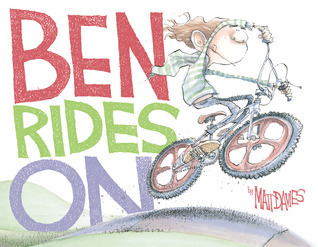 Ben Rides On
Ben Rides On
By Matt Davies
A Neal Porter Book, Roaring Brook Press (an imprint of Macmillan)
$16.99
ISBN: 978-1-59643-794-4
Ages 3-7
On shelves now.
The cartoonist as great children’s book author is not a given. Consider the sad case of Berkeley Breathed, for example. He achieved levels of unattainable brilliance when he penned Bloom County but his picture books have never managed to hit the same emotional beats, no matter how hard they try. Don’t get me wrong. Some cartoonists, like Stephan Pastis or the occasional New Yorker cartoonist, like Harry Bliss, excel in pleasing their child readers. All I’m saying is that when a Pulitzer Prize winner for editorial cartooning like Matt Davies comes along, you don’t necessarily know what you’re gonna get. All the more reason to be thrilled when the man gets it right. And by “it” I mean the picture book genre. Perfectly paced, expertly drawn, with enough humor and inventiveness to separate it from the pack, what we have here is a shining example of how to do a picture book correctly. Let the cartoonists have their day. Some of them know what they’re doing.
 Ben is your average joe. No flash. No panache. He just goes about his day. His one possession that pleases him more than any other is his fantastic bicycle. Ben rides it hither and thither on his way to school, only to have it stolen outright by nasty Adrian Underbite. Ben’s feeling pretty low at this point, up until he hears a strange noise after school. As fate will have it, Adrian has been thrown by the now busted bike and is hanging from a cliff. Ben is perfectly content to let his enemy meet his just desserts but something stops him. He rescues his foe, and the result . . . well, it’s not what he expects, let’s just say that.
Ben is your average joe. No flash. No panache. He just goes about his day. His one possession that pleases him more than any other is his fantastic bicycle. Ben rides it hither and thither on his way to school, only to have it stolen outright by nasty Adrian Underbite. Ben’s feeling pretty low at this point, up until he hears a strange noise after school. As fate will have it, Adrian has been thrown by the now busted bike and is hanging from a cliff. Ben is perfectly content to let his enemy meet his just desserts but something stops him. He rescues his foe, and the result . . . well, it’s not what he expects, let’s just say that.
Bully books. If upon reading these two words you’ve just suppressed an inward groan, I hear you. It sounds bad but right now we’re in the midst of a bullying craze. Bullies are hotter than ever, so any time you encounter one in a book for kids you naturally have to assume that there will be some kind of “don’t bully” moral imparted to the reader. What we sometimes forget is that bullies are, and have always been, perfect children’s book villains. From Bugs Meaney to Miss Trunchbull to Malfoy, bullies aren’t fad baddies. What’s nice about Ben Rides On is that it harkens back to good old-fashioned brainless goons, while also offering some possible redemption on the side. Adrian Underbite is everything his name suggests and he’s a classic bully type: Physically intimidating and mean. Yet he’s redeemed in the end after it appears that he has returned to his old ways. Bullies in picture books don’t tend to get a lot of redemption. Redemption in picture book is rare in any case. There are moments of grace but considering how short your average picture book is (32 pages is the average) there’s not a lot of room there for character development, a climax, a change of heart, and forgiveness. Yet Matt Davies shows here how clearly it can be done.
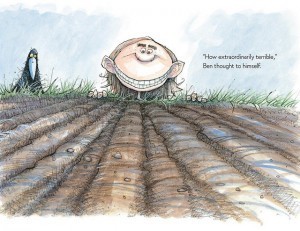 There are certain types of picture books that appeal to me upon contact, so to speak. They have a look or a style to them that pleases. What was it about Ben Rides On that first attracted me? Maybe it was the use of line. That frantic pen and ink that’s so cross-hatched and irregular that your eye is instantly drawn to it. When seated on his bike, Ben’s wheels never touch the ground (Adrian’s do). When he’s grounded the book takes time to concentrate on other details. Things like the repeating thundercloud motif that appears over anyone’s head when they’re upset (it’s the same as the image on Adrian’s shirt too: discuss). Or cool visual pieces, like the solitary, dejected Ben walking down a school hallway, or the oversized underside of his shoe as he runs to a mysterious sound. I love how the angles and shots (for lack of a better word) of the characters move about constantly. It’s the kind of drawing that rookie illustrators forget to do when they first make their books. The best image in the book, bar none, is the moment when Ben looks down upon his now helpless opponent and you get a kind of Adrian-eye-view of the face distorted by an evil grin. Reads the accompanying text, ” ‘How extraordinarily terrible,’ Ben thought to himself.” There’s a nice juxtaposition here between what Ben is saying and what he means. Terrible, is clearly the outcome Ben would have most wished upon Adrian. Terrible, is a wonderful thing.
There are certain types of picture books that appeal to me upon contact, so to speak. They have a look or a style to them that pleases. What was it about Ben Rides On that first attracted me? Maybe it was the use of line. That frantic pen and ink that’s so cross-hatched and irregular that your eye is instantly drawn to it. When seated on his bike, Ben’s wheels never touch the ground (Adrian’s do). When he’s grounded the book takes time to concentrate on other details. Things like the repeating thundercloud motif that appears over anyone’s head when they’re upset (it’s the same as the image on Adrian’s shirt too: discuss). Or cool visual pieces, like the solitary, dejected Ben walking down a school hallway, or the oversized underside of his shoe as he runs to a mysterious sound. I love how the angles and shots (for lack of a better word) of the characters move about constantly. It’s the kind of drawing that rookie illustrators forget to do when they first make their books. The best image in the book, bar none, is the moment when Ben looks down upon his now helpless opponent and you get a kind of Adrian-eye-view of the face distorted by an evil grin. Reads the accompanying text, ” ‘How extraordinarily terrible,’ Ben thought to himself.” There’s a nice juxtaposition here between what Ben is saying and what he means. Terrible, is clearly the outcome Ben would have most wished upon Adrian. Terrible, is a wonderful thing.
This is not to say that there aren’t some choices that made me scratch my head in confusion. The final shot in the book, for example, is a touch baffling. Not to spoil anything for you (if picture book spoilers are the bane of your existence, you may perhaps wish to do other things with your life) but the last shot of the book is of Ben’s bike, now perfectly repaired by Adrian, down to the band-aid on the bike seat. It’s a nice image, but for some reason that I still can’t quite figure out the image of the bike appears within a circle. It looks as though you’re viewing the bike through a telescope of some sort. I searched through the book to see if Ben owned such an object, but couldn’t find any evidence of it. Then I realized that the way the book has set this shot up, the only way a person could see a bike like this would be if they were across the street from Ben’s house looking back. Maybe through a peephole in a door? Are we to assume that Adrian is now hiding and waiting for Ben to find the bike? It’s possible that this is meant to invoke old Warner Brothers cartoons with the circle closing in on the action, but there weren’t really any particularly cartoonish elements before now (except perhaps the Wile E. Coyote-like dangling off a cliff of Adrian). It’s a puzzle.
A comic strip is like a picture book shortened within an inch of its life. It demands that the writer know how to synthesize a story into only three panels. An editorial cartoon, by contrast, is an even shorter affair, needing to present all the pertinent information in a single point. You would think then that editorial cartoonists would then be at a distinct disadvantage to their funny pages friends when they start writing picture books, but we know that is not the case. Here’s a fun fact: One of the most celebrated children’s picture book illustrators out there started his life as a political cartoonist. If this were a game of Jeopardy, now would be the time for you to say, “Who is David Small?” and you would be correct. Now Matt Davies joins his ranks and though it’s his first time at bat, he’s knocked it out of the park. A step above the generally bully fare found these days, here’s a book with its heart in the right place, that could actually enthrall and engage its listeners. Boo-yah.
On shelves now.
Like This? Then Try:
Phoebe and Digger by Tricia Springstubb, ill. Jeff Newman
Big Red Lollipop by Rukhsana Khan
Big Mean Mike by Michelle Knudsen
Professional Reviews: A star from Kirkus
August 30, 2013
Fusenews: Like a common peasant
 They say that there are more children’s book authors and illustrators in Brooklyn than any other city in the nation. How appropriate then that they should be the ones behind the inaugural Atlantic Avenue Children’s Literature Contest. The rules are simple: If you have never written a published children’s book then you are eligible. You simply submit your 800 words or less picture book manuscript and an esteemed panel of judges will determine your work’s relative delights. The top prize gets $1000. Couldn’t you use $1000? Of course you could. Many thanks to Pat Cummings and Sergio Ruzzier for the tip.
They say that there are more children’s book authors and illustrators in Brooklyn than any other city in the nation. How appropriate then that they should be the ones behind the inaugural Atlantic Avenue Children’s Literature Contest. The rules are simple: If you have never written a published children’s book then you are eligible. You simply submit your 800 words or less picture book manuscript and an esteemed panel of judges will determine your work’s relative delights. The top prize gets $1000. Couldn’t you use $1000? Of course you could. Many thanks to Pat Cummings and Sergio Ruzzier for the tip.You might call this a screed and to a certain extent you’d be right. I would advise then that when you read School Is No Place for a Reader (from Canadian Notes & Queries) you select the portions of the article that apply best to you and your situation and act accordingly. Plus there’s a really remarkable little mention of Matilda in this piece, and everybody loves Matilda.
I have six words for you today: Abandoned Wizard of Oz theme park. Anyone else who looks at this post and fails to have Road to Oz flashbacks is just fooling themselves. I shall post a single solitary image from the link. It speaks for itself, I think.
Ah. Here we go. Pinterest working in the name of good rather than evil. Today’s entry: 25 Signs You’re Addicted to Books. The staff picks note is dead on. Thanks to Aunt Judy for the link.
Because she loves you and you have been good, Marjorie Ingall has followed up her Children’s Book Footwear post with a follow-up. All you need to know is that at some point she incorporates the following shoe:
On your darker days you might fear that people don’t get mad enough. They sit passively by and watch horrendous things occur without so much as blinking their piggy little eyes. It can be a real relief when folks get mad. It was a relief this week, that’s for sure. Fight the good fight, people!
I can’t be alone in this. Is there any reason you can think of that Kadir Nelson isn’t doing every single stamp for the U.S. Post Office from here on in? I mean, sure, he’d have to take time off to make a children’s book every once in a while, but are they fools? You hire that man and you don’t ever let him go.
Some on-set photos from the film version of Alexander and the Terrible, Horrible, No Good, Very Bad Day have emerged. Who knew Jennifer Garner had such original toddler holding skills? I am referring, of course, to the second to last photo. Thanks, yet again again, to Marjorie Ingall for the link.
When people ask me for a list of my favorite YA book blogs I tend to mention, amongst many things, The Book Smugglers. Those gals have great taste and a tone of voice worth fighting for. I tend to forget that they sometimes do middle grade books as well. In their recent Middle Grade Roundtable they brought in some top talent to discuss some truly old school titles. Thanks to Tea Cozy for the link.
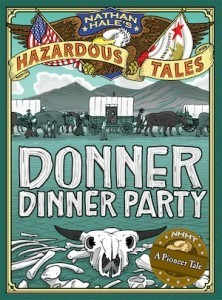 I usually see a whole lot of children’s books before their publication dates. No brag. Just fact. The end result is that when I cannot get my hands on something early, I want it more than anything else in the world. Case in point: Nathan Hale’s latest Hazardous Tale Donner Dinner Party. For the first time in I don’t know when, I had to put a hold on a book so that when it was published I’d get a copy as soon as possible. I then proceeded to read it in one sitting. It’s just that good. Now I’m happy to see that Nathan Hale has been interviewed about the book over at fellow SLJ blog Good Comics for Kids. Read it and you’ll find out what he considered the most surprising fact about the Donner Party story and what he’s working on next.
I usually see a whole lot of children’s books before their publication dates. No brag. Just fact. The end result is that when I cannot get my hands on something early, I want it more than anything else in the world. Case in point: Nathan Hale’s latest Hazardous Tale Donner Dinner Party. For the first time in I don’t know when, I had to put a hold on a book so that when it was published I’d get a copy as soon as possible. I then proceeded to read it in one sitting. It’s just that good. Now I’m happy to see that Nathan Hale has been interviewed about the book over at fellow SLJ blog Good Comics for Kids. Read it and you’ll find out what he considered the most surprising fact about the Donner Party story and what he’s working on next.
Awww yeah. This is the good stuff. Recently NYPL hosted its first Education Innovation @ NYPL Summer Institute where, over the course of three weeks, some lucky teachers “met curators from our Research Divisions, explored our Archives, and connected with members of our Strategy Department—all with the intention of addressing how we can better identify materials from our collections for use in the classroom, and how we can better connect these materials to teachers.” Now it’s time to behold (and take advantage of) the fruits of their labors. Each teacher choose a research topic to build a lesson plan around, and then explored our archives to uncover primary source materials to enhance their knowledge and teaching of this topic. They’ll be writing blog posts about these materials soon, but at the moment they’ve constructed these annotated lists of primary and secondary materials for classroom use. Check out everything from “Latinos on Broadway” to “Kids in African-American Civil Rights Protests” here at Classroom Connections. And the first blog post Slavery and the Underground Railroad for Grades 6-8 is already up and running if you’re curious.
This is why we love Phil Nel. Who else has reported on their blogs about the 2013 International Research Society for Children’s Literature (IRSCL) conference held this year in Maastricht? No one I know. But Phil makes the who experience fun and interesting. The street lights alone are worth the price of admission.
It’s nice when folks in places like Reuters praise libraries. Nice too when they mention my own.
Daily Image:
It’s that time of year.
Well played, Grand Forks Public Library. Well played indeed. Thanks to Amie Wright for the link.
August 28, 2013
Review of the Day: Farmer Will Allen and the Growing Table by Jacqueline Briggs Martin
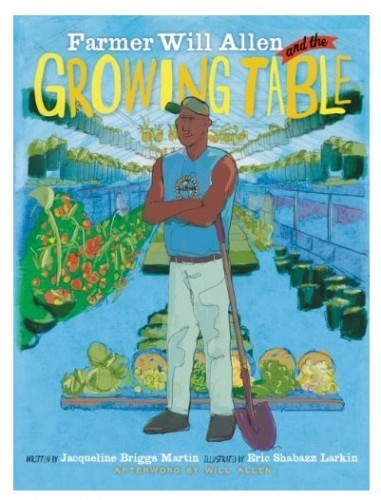 Farmer Will Allen and the Growing Table
Farmer Will Allen and the Growing Table
By Jacqueline Briggs Martin
Illustrated by Eric-Shabazz Larkin
Readers to Eaters Books
ISBN: 978-0-9836615-3-5
$17.95
Ages 4-8
On shelves September 10th
It shouldn’t be this hard. You walk to a biography section of a children’s room, any children’s room, and you start searching for biographies of living people who are not sports stars, actors, musicians or politicians. And you search. And you search. And after a while your eyes kind of droop and you feel a bit sleepy, so you tell yourself you’ll continue to search on another day. Don’t bother. I can tell you right off that finding biographies of contemporary people who don’t fall into the worlds of sports, entertainment, or politics is a fool’s errand. Average extraordinary people tend to be lumped in group biographies if anywhere at all. That’s part of what makes Farmer Will Allen and the Growing Table such a rarity. Part biography, part paean to urban gardens and gardeners everywhere. The book is a beautiful tribute not just to its hero Will Allen but also to the right of every child to have access to good, healthy, cheap food. The ultimate picture book about muncha muncha muncha.
Actually, I’ll level with you. Will Allen really was a basketball player. At first anyway. Though he grew up in a family that grew most of its own food, he wasn’t a fan of the work. As soon as he could he left those Maryland fields for college and became a professional basketball player in Belgium. While over there a friend asked for some help digging potatoes and the next thing Will knew he was hooked. After moving back to the States he adopted six empty, abandoned greenhouses in Milwaukee. What followed was years of trial and error as Will worked to turn his lots into working gardens. With the help of the community (and more than a few red wigglers) Will didn’t just get those greenhouses working, but city garden plots around the country too. Now he speaks everywhere from Kenya to London, teaching people how to grow food for themselves. The good news? Will Allen sees things other people can’t. And “when he sees kids, he sees farmers”.
 I think there’s a danger of adults falling into this belief that kids only want to read about other kids. Our memories of childhood may skew a bit, and when we think of books written for children, a lot of the time we assume that kids aren’t going to want to read about people too much older than themselves. Of course, as one friend of mine put it recently, “That’s what people who don’t interact with kids at all think.” It is far from the truth. Children love hearing about adults. Adults hold an allure of their very own. For a child, reading about adults offers them both distance (“I will never be that old”) and promise (“I could live that life”). But to write a book for kids about an adult that isn’t a household name (yet) you need a good author. Enter Jacqueline Briggs Martin.
I think there’s a danger of adults falling into this belief that kids only want to read about other kids. Our memories of childhood may skew a bit, and when we think of books written for children, a lot of the time we assume that kids aren’t going to want to read about people too much older than themselves. Of course, as one friend of mine put it recently, “That’s what people who don’t interact with kids at all think.” It is far from the truth. Children love hearing about adults. Adults hold an allure of their very own. For a child, reading about adults offers them both distance (“I will never be that old”) and promise (“I could live that life”). But to write a book for kids about an adult that isn’t a household name (yet) you need a good author. Enter Jacqueline Briggs Martin.
Now Ms. Martin holds the distinction of being one of the very few nonfiction picture book authors to win a Caldecott Award for one of her books (Snowflake Bentley. Typically Caldecotts go to fictional fare. That’s not born out of any innate prejudice. It’s more that until recently there haven’t been great swaths of fabulous illustrated nonfiction to chose from. Ms. Martin’s books seek to change all that and Farmer Will Allen is a step in the right direction. As an author, Ms. Martin has never gone with expected topics, though in this particular case she’s showing her hand. You see back in 1997 she penned The Green Truck Garden Giveaway: A Neighborhood Story and Almanac. In that book she told the tale of two people who drive around in a truck giving away little “bucket gardens”. Clearly her love of gardening in unexpected places has only grown in the intervening sixteen years.
In Will Allen Martin translates her love of gardening into an honestly good story. In general, realistic lives aren’t tailor made for literature. Life is too messy. Too complicated. What Martin is capable of doing then is of plucking only the essentials from Mr. Allen. That done, she sets about talking about healthy food, a difficult topic if only because a lesser author would give in to the temptation to preach. We live in an era where fatty, salty, oily food is so much cheaper than food that is good for us. Fruits and vegetables are sold everywhere but they aren’t free. So while we talk about the rise in obesity levels in the United States, it just makes sense to talk about how economics affect access to healthy alternatives. And part of what makes Farmer Will Allen such a good story is that it draws that connection without getting anywhere near a soapbox.
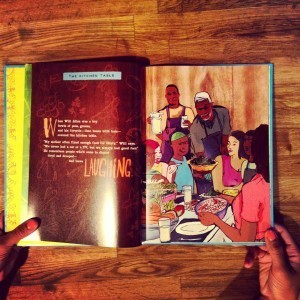 If you had told me after reading this that this was illustrator Eric-Shabazz Larkin’s first book for children I would not have believed you. Indeed, I’m having a hard time believing it even after I looked up his biography. The fact of the matter is that even when a magnificently talented artist attempts their first picture book for kids, they usually have a hard time with the design and layout. The truth? Most of the time it feels like they’re phoning it in. Not Larkin. With ink and pen and markers (as well as some digital work for flair), the man constructs a life. He knows where to put the text and how to incorporate it into the images. Basketballs turn effortlessly into potatoes. The Statue of Liberty is pictured holding a bunch of beets and somehow manages to look imposing and impressive rather than downright ridiculous. There are color washes in this book that glow on the page and the typography (which I normally never notice) is magnificent. Now as to the question of accuracy, I suspect that Larkin didn’t do too much research in terms of Allen’s home life as a child. When we see little Will Allen standing in a child’s version of his customary blue sleeveless t-shirt and green baseball hat, we’re straining the edges of credulity. That said, the image is more representational than a strict history. I think I’m okay with it. Faux dialogue in nonfiction picture books tends to drive me nutty, but imagined childhoods? Personally it raises no red flags for me. You might feel differently.
If you had told me after reading this that this was illustrator Eric-Shabazz Larkin’s first book for children I would not have believed you. Indeed, I’m having a hard time believing it even after I looked up his biography. The fact of the matter is that even when a magnificently talented artist attempts their first picture book for kids, they usually have a hard time with the design and layout. The truth? Most of the time it feels like they’re phoning it in. Not Larkin. With ink and pen and markers (as well as some digital work for flair), the man constructs a life. He knows where to put the text and how to incorporate it into the images. Basketballs turn effortlessly into potatoes. The Statue of Liberty is pictured holding a bunch of beets and somehow manages to look imposing and impressive rather than downright ridiculous. There are color washes in this book that glow on the page and the typography (which I normally never notice) is magnificent. Now as to the question of accuracy, I suspect that Larkin didn’t do too much research in terms of Allen’s home life as a child. When we see little Will Allen standing in a child’s version of his customary blue sleeveless t-shirt and green baseball hat, we’re straining the edges of credulity. That said, the image is more representational than a strict history. I think I’m okay with it. Faux dialogue in nonfiction picture books tends to drive me nutty, but imagined childhoods? Personally it raises no red flags for me. You might feel differently.
I can tell you right now that Farmer Will Allen and the Growing Table will not be shelved in my library’s biography section. Maybe you see that as a mistake, but for me it’s the only way to get the doggone thing into the hands of readers. The likelihood that a child is going to walk into a library anywhere (except possibly Milwaukee) saying, “I want a biography of Will Allen” is slim at best. The likelihood of a kid walking in saying, “I need a book on city gardens” or urban gardens, or composting, or gardening in general, is significantly higher. As a librarian, my job is to get this book into the hands of as many readers as possible. Fortunately, Martin’s topic and Larkin’s art combined with Allen’s story make this a sure-fire winner. We live in an era where food is falling under greater and greater scrutiny. Apply those standards to your child’s nonfiction picture book fare and Farmer Will Allen and the Growing Table passes all the tests with flying colors. Fun and informative by turns, raise a carrot or cabbage in honor of this awesome dude and his equally awesome tale.
On shelves September 10th.
Source: Final copy sent from publisher for review.
Like This? Then Try:
It’s Our Garden: From Seeds to Harvest in a School Garden by George Ancona
Potatoes on Rooftops: Farming in the City by Hadley Dyer
City Green by DyAnne DiSalvo
Other Reviews: From members of the International Reading Association’s Children’s Literature and Reading Special Interest Group (CL/R SIG).
Misc: Ms. Briggs answers some questions about the book including one where she casts Danny Glover in the role of Will (I’d go with Idris Elba myself)
Video:
Illustrator Eric-Shabazz Larkin discusses the book and pages through for you to see.
August 26, 2013
The New National Ambassador of Young People’s Literature: Who’s It Gonna Be?
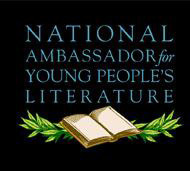 There must be a psychological disorder associated with an extreme preference for speculation over cold hard facts. Or, at the very least, a layman’s term for it. But until I research this fully, let us indulge my proclivities and talk a little about the National Ambassador of Young People’s Literature and all that it entails. Which is to say, who’s the next one gonna be?
There must be a psychological disorder associated with an extreme preference for speculation over cold hard facts. Or, at the very least, a layman’s term for it. But until I research this fully, let us indulge my proclivities and talk a little about the National Ambassador of Young People’s Literature and all that it entails. Which is to say, who’s the next one gonna be?
As you may know, the position originated with Jon Scieszka who wore his bedazzled sash like a veritable king (and earned great and very silly acclaim in situations like this one). Sciezka, after serving his two-year term, was succeeded by Katherine Paterson who, in turn, was succeeded by Walter Dean Myers.
Two years ago, on September 15, 2011, I wrote a post called Who Should Be the Next National Ambassador of Young People’s Literature in which I proceeded to nail it. Oh, the nailing of it that was done! I so rarely score well with my predictions that the appointment of Myers quite went to my head. I am giddy, nay drunk, with success. Which brings us to today.
Within the next week or two, a mysterious cabal of children’s literature enthusiasts will gather to determine our next Ambassador. And though the requirements are as free and breezy as the wind, there are certain attributes that will make one person preferable over another. These would include (and they have not changed much since the last time I discussed this position):
- The Ambassador must be a household name to people who are not necessarily children’s librarians, booksellers, etc. I’ve added this requirement and I think it sticks. When they choose an Ambassador they like it when they can tell NPR or The New York Times or what have you that the person wrote [enter famous book here]. This is not a hard and fast requirement and I’m sure they could bend it for an overqualified candidate, but I suspect that in the back of the nominating committee’s mind, the idea is there.
- The Ambassador must have grown children if they have any children at all. An Ambassador zips around the country/world doing good work. If they have kids that need them at home they’re not going to be able to fulfill their Ambassadorial duties to the full.
- The Ambassador must be personable. An Ambassador who doesn’t know how to speak to a large group and, on some level, enthrall, is not going to qualify for this job. You need someone who can command a room.
- The Ambassador should have a cause that he/she promotes that is not him/her own self. Not that they won’t be able to promote their own stuff. In fact, it helps if they’re still writing. The Ambassador is able to promote their latest works essentially for free when they have this gig. That’s no small potatoes, but they also need to have something they believe in. Hence, Scieszka getting boys to continue reading, Paterson as the vice president of the National Children’s Book and Literacy Alliance, and Myers has basically been an advocate for innumerable causes for the last few decades of his life (great PBS bit on him here).
So. With all these in mind, who’s it gonna be?
Looking at the pattern we’ve had a boy, a girl, and a boy. That means the odds are good that the choice is going to swing to the “girl” side again. Even more so when you consider that potential female Ambassadors are easier to find than male (insofar as I can tell it’s Richard Peck or nothing). Look at the sheer range of women and two names spring immediately to mind. Therefore my top two choices are:
 Judy Blume – You can just tick off the requirements one by one with Judy. Is she a household name? As I figure it, if Saturday Night Live does a skit based on your novels and starring John Malkovich, you are officially the biggest American name in children’s literature. That’s where the bar falls. Does she have grown children? Yes and she makes movies with them. Is she personable? Baby, you haven’t been charmed till you’ve been charmed by the Blume. She’s dangerously close to garnering enough love that folks create a religion in her name (Blumeism . . . oh, you know it’s gonna happen). As for the cause, can you think of anyone else who is as close to a poster child for anti-censorship as Ms. Blume? And we haven’t had an anti-censorship ambassador yet. It’s perfect! The only thing that keeps her from being my #1 choice is the fact that the woman is terribly busy. She doesn’t slow down. As such, while they might ask her to be Ambassador (and, indeed, I suspect they may have already done so in the past) I don’t know that she’d necessarily take it. That leaves . . .
Judy Blume – You can just tick off the requirements one by one with Judy. Is she a household name? As I figure it, if Saturday Night Live does a skit based on your novels and starring John Malkovich, you are officially the biggest American name in children’s literature. That’s where the bar falls. Does she have grown children? Yes and she makes movies with them. Is she personable? Baby, you haven’t been charmed till you’ve been charmed by the Blume. She’s dangerously close to garnering enough love that folks create a religion in her name (Blumeism . . . oh, you know it’s gonna happen). As for the cause, can you think of anyone else who is as close to a poster child for anti-censorship as Ms. Blume? And we haven’t had an anti-censorship ambassador yet. It’s perfect! The only thing that keeps her from being my #1 choice is the fact that the woman is terribly busy. She doesn’t slow down. As such, while they might ask her to be Ambassador (and, indeed, I suspect they may have already done so in the past) I don’t know that she’d necessarily take it. That leaves . . .
 Lois Lowry – The timing, in this case, is perfect. Why? Because not only does she continue to write and talk in public to an amazing degree, but some time in the next two years we’ll see the release of the movie version of The Giver (starring , , and with a 24-year-old Jonas but that’s neither here nor there). It’s a little too perfect. Once the movie is released, Lowry will be asked to speak all the time anyway, and that in turn will shine a bright light on the Ambassadorship and whatever causes she’d most like to promote. The stars align perfectly for Ms. Lowry. She’s a great age, lots of personality and stamina, blue eyes that can pierce you to your soul, and if she wasn’t a household name before she certainly will be soon. So with much consideration I’m putting my money on Ms. Lowry. Could well be that I’m wrong and we end up with a Jacqueline Woodson or Linda Sue Park (which I would love). We shall see what we shall see. Exciting!
Lois Lowry – The timing, in this case, is perfect. Why? Because not only does she continue to write and talk in public to an amazing degree, but some time in the next two years we’ll see the release of the movie version of The Giver (starring , , and with a 24-year-old Jonas but that’s neither here nor there). It’s a little too perfect. Once the movie is released, Lowry will be asked to speak all the time anyway, and that in turn will shine a bright light on the Ambassadorship and whatever causes she’d most like to promote. The stars align perfectly for Ms. Lowry. She’s a great age, lots of personality and stamina, blue eyes that can pierce you to your soul, and if she wasn’t a household name before she certainly will be soon. So with much consideration I’m putting my money on Ms. Lowry. Could well be that I’m wrong and we end up with a Jacqueline Woodson or Linda Sue Park (which I would love). We shall see what we shall see. Exciting!
So who’s your top pick?
August 25, 2013
Video Sunday: If I could chose my own cool library name I’d go with “In Transit”
A conservative estimate would say that around seven people sent me this particular video this week. A hat tip to every last person who set out to alert then. I wasn’t necessarily going to make a Video Sunday this week, but after watching this I just couldn’t pass this up. The editing, man, the editing!!
Now the customary book trailer to start things off on the right note. Today we’re enjoying one with live kid actors (a trend I’ve covered before). It’s Jack Strong Takes a Stand by Tommy Greenwald.
I just like any video that uses the chain gang song.
I find this next video vastly important to those of us in the library game, and I think it speaks for itself. From a blog piece at thewikiman called How we made a (pretty nice) virtual Library Tour video for almost no money, the piece covers the basics on how to make a good, accessible, cheap, smart library tour for incoming freshmen at a university. No reason this can’t be adapted to a school library setting, though. Or even the public library sphere. Great advice, and a good video. Read the blog post, but also watch the video if you’ve half a mind to.
To the already listed advice I would add, “Give everyone British accents”. Poor Americans. We’re hardwired to find anyone with those accents smart. It’s our nature. Thanks to AL Direct for the link.
These days the Scholastic Book Group is getting all kinds of virtual. They’ve a nifty blog called Book Box Daily which provides all sort o’ info for the masses. They also happen to have these cute little videos for distinct books that they like. For example, here you will find Mia Cabana (who reminds us that Scholastic is located in Soho – so I would like all of you to fall under the mistaken impression that I dress like this too) discusses The Year of the Book by Andrea Cheng. The craft makes for a nice touch.
And for our off-topic video, I am 98.5% convinced I already posted this once before but my files say otherwise. In any case, it’s beautiful enough that I don’t particularly care if I’m repeating myself. It’s from a show called The Icebook. More than that I can’t say.
Thanks to Children’s Illustration for the link.
August 24, 2013
2014: It’s Never Too Early to Get Excited
Howdy, folks!
So as crazy as it sounds, some 2014 titles have been wandering into my branch. And if that weren’t enough, some of them look positively awesome. With the given understanding that I’ve only read a few of these (and they were picture books, so I’m not exactly straining my abilities here) I present to you some 2014 titles that I, at the very least, am rather interested in taking a closer gander at on January 1st:
Five, Six, Seven, Nate by Tim Federle
It’s almost here! For those of you who, like myself, enjoyed Federle’s 2013 debut in Better Nate Than Ever (I watch the trades daily for the moment when E.T.: The Musical actually becomes a reality), the sequel is on the horizon.
Yellow Is My Color Star by Judy Horacek
When Horacek appeared on the U.S. stage again this year with Mem Fox’s Time for Bed, I was thrilled. I consider her work on Where Is the Green Sheep? to be a seminal delight. Now Horacek’s breaking out on her own, and here’s the result. Man oh man, I like how she draws people.
Eye to Eye: How Animals See the World by Steve Jenkins
He’s done bones. He’s done why you should smile at monkeys. He’s done the actual size of gorilla hands, and the best way to clean hippos, and all manner of interesting stuff. Now he tackles eyeballs. And to this we say, high bloody time.
How to Cheer Up Dad by Fred Koehler
THIS is how you write a picture book. It is amazing. The kid perspective is spot on from start to finish. Keep tabs on Koehler. He’s one to watch.
The Nightingale’s Nest by Nikki Lofton
I could have just taken the official jacket and used it for this post but I wanted you to see the sheer number of blurbs they have all over the galley’s cover. This is just a smattering. I think they’re on the back and maybe inside as well. Note too that it’s a book starring an African-American girl. Penguin is making a concerted effort in 2014 to up the number of multicultural characters in middle grade books. As you will soon see.
Sparky by Jenny Offill, illustrated by Chris Appelhans
No. Do not even attempt to resist this. You cannot. You are powerless against it. I’m going to go out on a limb (ha ha) right now and say this: With apologies to Eric Carle, this is the best damn sloth-related picture book I have ever read.
Princess Sparkle-Heart Gets a Makeover by Josh Schneider
Adoration. There is little else that I can say. The love I feel for this is extreme. It’s the ending, man. I’m not even going to ruin it for you. Just read this when you can.
Henny by Elizabeth Rose Stanton
Because sometimes you gotta love the weird. Weird is easy to write but hard to do well. This book is about a chicken with human arms. To those of you who are instantly interested, this one’s for you. It is done exceedingly well.
The Ghost of Tupelo Landing by Sheila Turnage
Helloooooooo, sequel to Three Times Lucky! And with a ghost to boot? Woo-hoo!
Saving Baby Doe by Danette Vigilante
Don’t know much about this one but the cover’s great and the author’s last name is “Vigilante”.
The Blossoming Universe of Violet Diamond by Brenda Woods
If the name “Brenda Woods” sounds familiar, she’s the one who wrote St. Louis Armstrong Beach a couple years ago. On the strength of that I’m looking forward to reading this one as well.
August 23, 2013
Review of the Day – Africa Is My Home: A Child of the Amistad by Monica Edinger
 Africa Is My Home: A Child of the Amistad
Africa Is My Home: A Child of the Amistad
By Monica Edinger
Illustrated by Robert Byrd
Candlewick Press
$17.99
ISBN: 978-0-7636-5038-4
Ages 9-12
On shelves October 8th
It’s no secret that nonfiction in children’s literature is the buzzword of the day. Thanks to the rise of interest in the Core Curriculum State Standards, kids are currently being urged to read more and more nonfiction in all its many myriad forms. The results are mixed. On the one hand we’re seeing more attention paid to some fine pieces of nonfiction that might otherwise have sunk below the radar. By the same token, some truly terrible nonfiction is getting forced down the gullets of our children by well meaning adults who don’t know the difference between quality and schlock. Even more disturbing, publishers are starting to relabel works of fiction as “nonfiction” on the weakest of justifications. It takes guts for someone to start to write something as nonfiction, then stop, think about it, and proceed to change course entirely and label the work fiction after all. There’s a backbone of integrity to Monica Edinger’s Africa Is My Home: A Child of the Amistad. Though it could easily have been labeled nonfiction, the author and publisher opted instead to give themselves a bit of leverage. 95% of what you’ll read here is true. More to the point, it’s fascinating. A little known story filled with original research that’s a great read from start to finish.
Born in Mendeland, West Africa, Magulu lived amongst family and greenery until the famine struck. Starving, her father pawned his daughter in exchange for food in the hopes of repaying his debt after a year. Yet before the debt was paid, the greedy villager sells Magulu to slave traders that can offer more than her father. On a slave ship called The Amistad she befriends the other children as well as a captive named Cinque. Through Cinque they learn of a rebellion brewing to overthrow the slavers above. The plan works but attempts to steer home to West Africa are thwarted. The Africans are taken to jail in New Haven and there Magulu begins to learn more about the land where she has landed. Yet through it all she never stops thinking of home. Behold one of the rare true tales of 19th century slavery that has an honestly happy ending.
Edinger did originally attempt to write this book as a straight work of nonfiction. As she writes in the Author’s Note, Edinger was forced to choose between writing a book that makes assumptions every step of the way and going the fiction route. She chose the latter. A wise move, honestly, since I can’t tell you how many “nonfiction” books I’ve read this year alone that make broad, all-compassing assumptions but couch them within the words “probably” and “perhaps”, assuming that this will make everything fine and dandy. Freed from the restrictions of nonfiction, Edinger is free to say how Magulu feels about everything from the awfulness of female 19th century dress to snow (which is awesome at first and then, in time, dreary). Her intentions in terms of religion and how she chose to live out the rest of her life has roots in the experiences of her youth. With some extrapolation, it all comes together.
Of course the ultimate irony is that the book is better cited, with more primary source documents and original research, than much of the nonfiction for kids you’ll find today. Edinger took the time to seek out every possible reference she could find to Magulu, and to retrace her steps from New Haven to Farmington and Oberlin. She is able to actually find sympathetic engravings of Joseph Cinquez from the time period (no easy task, I suspect). An extensive bibliography of Selected Sources provides all the sources Ms. Edinger used in the course of her research. If there aren’t any children’s sources there’s a very good reason for that. This is the first book of its kind.
I have read my own fair share of fictional books set in Africa that were written by ex-Peace Corps members or teachers who lived there for a time, and I can tell you that the experience of living and working in Africa does not immediately translate into the ability to keep the book from patronizing the locals. Ms. Edinger mentions in her Author’s Note that she spent two years in Sierra Leone in the 1970s. That means her interests lie there, but do her abilities? With a relief felt deep in my bones I can tell you that the woman knows how to write. Her book doesn’t infantalize the characters. If Magulu feels amazed at things that are new to her, she is at least a kid. There’s a reality to her wonder. Now the Kirkus review of this book found fault with the timeline, saying that the, “narrative occasionally skips weeks or months without alerting readers.” I’m sure that if we were talking about a work of straight nonfiction this would indeed be problematic. As a work of fiction, I wasn’t particularly disturbed.
Then there was the question of religion. Magulu really did convert wholeheartedly and become known as Sarah Kinson when she was older. So if Edinger is to truly enter in the mind of her heroine, she has to show her slowly growing appreciation of the Christian religion. This is tricky territory that requires a kind of careful handling. Of course, none of the captives of the Amistad would have gotten home had it not been for church contributions. It’s not surprising to me that we don’t read many contemporary fictional works for kids that are sympathetic to Christian conversion. After all, it’s a hard topic to tackle well. But since Edinger, for all the that book is fiction, is attempting to veer as closely to the truth as possible, it was an unavoidable element.
The choice of Robert Byrd as illustrator was an interesting one. Byrd’s star has risen considerably, making him a go-to choice for illustrated nonfiction. What I find interesting about using him in this particular book is that he balances out the horror perfectly. Both he and Edinger had the unenviable task of telling a horrific tale (at least at the beginning) for small child readers. It’s important and needs to be told, and by the same token you can sugarcoat the truth. You can’t lie. Edinger handles this by being straightforward without being graphic. When the children come up after the attack on their Spanish captors she writes, “There was blood everywhere. White and African men lay dead and dying.” The accompanying picture is done almost without emotion. We see Africans and white men fighting with machetes and guns, but there’s no blood or grotesqueries. Compare this image with one earlier where Magulu is ripped from her mother’s arms by a slaver. “Sobbing, she held me tight until the traders pulled me away.” In the picture it is a far more peaceful scene, the girl between the two adults but without expression. It’s almost as if Byrd is protecting young readers by downplaying the raw emotions. The question is whether or not this is a good or bad thing. I think that as long as it isn’t displaying images that belies the text, the pictures have a use. This may all boil down to a deeper argument of the purpose of teaching children about the darker moments in history. Where this book lies on the spectrum is up for debate.
Aside from that, though, Byrd has done the book the ultimate service of making it beautiful. If the cover doesn’t convince you then consider the full page renderings of Magulu standing at the deck of a boat returning to Africa by moonlight. Or my personal favorites, the renderings of her dreams in the night of her mother, her father, and the village elders. The other nice thing is that Byrd doesn’t slip in some of the inaccurate images we too easily associate with the slave trade. For example, we’re all familiar with the image of white slavers traveling deep into the heart of Africa to capture slaves. The truth was more complicated than that, with white slavers often doing business with local Africans in procuring the slaves. The pictures reflect that reality.
If I had my way there would be a children’s literary award for every genre imaginable. From graphic and illustrated novels to poetry to comedy in a work of middle grade fiction. Add to that list “Books That Meld Fact and Fiction”. This encompasses every work of fiction based on the true life of a historical figure to some extent, but nothing comes close to Africa Is My Home in terms of sure research, heart, blood, sweat, and tears. Sometimes an author writes a book and you can see the strings. Which is to say, you can see them working as hard as they can to make the title successful. Other authors write a book and it works so well on the page as to seem effortless. That’s the general gist of Edinger’s first for kids. Not the last, one hopes. We need more books that aren’t afraid to take fiction to an entirely new level.
On shelves October 8th.
Source: Galley sent from publisher for review
Like This? Then Try:
Good Masters! Sweet Ladies! Voice from a Medieval Village by Monica Edinger
The Middle Passage: White Ships / Black Cargo by Tom Feelings
Stolen Into Slavery: The True Story of Solomon Northup by Judith Bloom Fradin
Professional Reviews: Kirkus
Video:
Gotta love the book trailer for this one. Just sublime.




